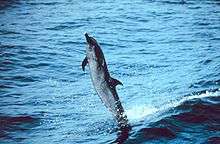List of mammals of Tuvalu

This is a list of the mammal species recorded in Tuvalu. There are 3 mammal species in Tuvalu identified in the IUCN Red List, all of which are marine mammals of the order Cetacea: Ginkgo-toothed Beaked Whale (Mesoplodon ginkgodens), Pygmy Killer Whale (Feresa attenuata) and Pantropical Spotted Dolphin (Stenella attenuata).[1]
The literature review by Miller (2006) found 4 additional cetaceans reported: Orca or Killer whale (Orcinus orca), Spinner Dolphin (Stenella longirostris), Bottlenose Dolphin (Tursiops truncatus) and Sperm Whale (Physeter macrocephalus ).[2][3] The Pantropical Spotted Dolphin (Stenella attenuata) is found in the lists of both Miller and the IUCN. The Pacific ocean surrounding Tuvalu is within the range of these cetaceans although sightings of some of these species may be infrequent.
A revision of the list of cetaceans reported in the ocean surrounding Tuvalu was carried by Miller (2009),[4] who listed ‘minke-like’ whale (Balaenoptera sp.) and diminutive sperm whale (Kogia sp.).[4]
The following tags are used to highlight each species' conservation status as assessed by the IUCN:
| DD | Data Deficient | There is inadequate information to make an assessment of the risks to this species. |
Some species were assessed using an earlier set of criteria. Species assessed using this system have the following instead of Near Threatened and Least Concern categories:
| LR/cd | Lower Risk/conservation dependent | Species which were the focus of conservation programmes and may have moved into a higher risk category if that programme was discontinued. |
| LR/nt | Lower Risk/near threatened | Species which are close to being classified as Vulnerable but are not the subject of conservation programmes. |
| LR/lc | Lower Risk/least concern | Species for which there are no identifiable risks. |
Subclass: Theria
Infraclass: Eutheria
Order: Cetacea (whales)
The order Cetacea includes whales, dolphins and porpoises. They are the mammals most fully adapted to aquatic life with a spindle-shaped nearly hairless body, protected by a thick layer of blubber, and forelimbs and tail modified to provide propulsion underwater.
- Suborder: Mysticeti
- Family: Balaenopteridae
- Subfamily: Balaenopterinae
- Genus: Balaenoptera
- Rorqual baleen whale: either Bryde's whale Balaenoptera brydei or sei whale B. borealis DD
- Genus: Balaenoptera
- Subfamily: Balaenopterinae
- Family: Balaenopteridae
- Suborder: Odontoceti
- Superfamily: Platanistoidea
- Family: Ziphidae
- Subfamily: Hyperoodontinae
- Genus: Mesoplodon
- Ginkgo-toothed Beaked Whale (Mesoplodon ginkgodens) DD
- Genus: Mesoplodon
- Subfamily: Hyperoodontinae
- Family: Ziphidae
- Family: Kogiidae
- Genus: Kogia
- Dwarf Sperm Whale Kogia sima LR/lc
- Family: Physeteridae
- Genus: Physeter
- Sperm Whale (Physeter macrocephalus) Vulnerable species VU
- Genus: Physeter
- Family: Delphinidae (marine dolphins)
- Genus: Stenella
- Pantropical Spotted Dolphin (Stenella attenuata) LR/cd
- Genus: Tursiops
- Bottlenose Dolphin (Tursiops truncatus) DD
- Genus: Stenella
- Spinner Dolphin (Stenella longirostris) LR/cd
- Genus: Feresa
- Pygmy Killer Whale (Feresa attenuata) DD
- Genus: Orcinus
- Genus: Stenella
- Genus: Kogia
- Superfamily: Platanistoidea
See also
- List of chordate orders
- List of regional mammals lists
- List of prehistoric mammals
- Mammal classification
- New mammal species
References
- "Tuvalu - Summary of species on the 2008 IUCN Red List" (PDF). IUCN. 2008. Retrieved 4 November 2011.
- "Mammal Species of the World". Smithsonian National Museum of Natural History. 2005. Archived from the original on 27 April 2007. Retrieved 22 May 2007.
- "Animal Diversity Web". University of Michigan Museum of Zoology. 1995–2006. Retrieved 22 May 2007.
- Edgar Waite published an account of The mammals, reptiles, and fishes of Funafuti (Australian Museum, Sydney, 1897).[6]
References
- ↑ This list is derived from the IUCN Red List which lists species of mammals and includes those mammals that have recently been classified as extinct (since 1500 AD). The taxonomy and naming of the individual species is based on those used in existing Wikipedia articles as of 21 May 2007 and supplemented by the common names and taxonomy from the IUCN, Smithsonian Institution, or University of Michigan where no Wikipedia article was available.
- ↑ Miller, Cara (14 February 2006). Current State of Knowledge of Cetacean Threats, Diversity and Habitats in the Pacific Islands Region. WDCS Australasia Inc. p. 98.
- ↑ "Secretariat of the Pacific Regional Environment Programme(SPREP)" (PDF). Pacific Islands Regional Species Programme 2008-2012. 2008. Retrieved 9 October 2013.
- 1 2 Miller, Cara (1 July 2009). Current State of Knowledge of Cetacean Threats, Diversity and Habitats in the Pacific Islands Region (PDF). WDCS Australasia Inc. pp. 49–50.
- ↑ http://uk.whales.org/sites/default/files/whales-and-dolphins-in-the-pacific-islands.pdf
- ↑ Waite, Edgar R. (1897). The mammals, reptiles, and fishes of Funafuti (PDF). Australian Museum Memoir 3(3): 165–202.
